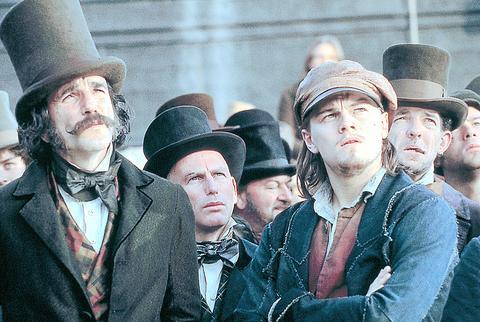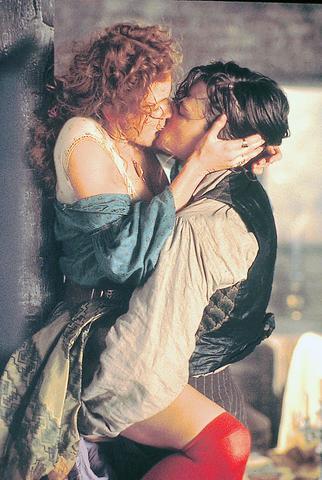Gangs of New York, Martin Scorsese's brutal, flawed and indelible epic of 19th-century urban criminality, begins in a mud-walled, torchlighted cavern, where a group of warriors prepare for battle, arming themselves with clubs and blades and armoring themselves in motley leather and cloth. Though this is Lower Manhattan in 1846, it might as well be the Middle Ages or the time of Gilgamesh: these warlike rituals have an archaic, archetypal feeling.
And the participants are aware of this. As the members of various colorfully named Irish gangs emerge into the winter daylight of Paradise Square (a place long since given over to high-rises and resurrected here on the grounds of the vast Cinecitt studio complex in Rome), their native-born Protestant enemies greet them with an invocation of "the ancient laws of combat." The ensuing melee turns the new-fallen snow pink with blood and claims the life of Priest Vallon (Liam Neeson), an Irish gang chieftain whose young son witnesses the carnage.

PHOTO: GROUP POWER
Sixteen years later, the boy, whose name is Amsterdam, has grown into Leonardo DiCaprio, his wide, implacable face framed by lank hair and a wispy Van Dyke. He returns from a long stint in the Hell Gate Reformatory to his old neighborhood, the Five Points, and finds it ruled by his father's killer, Bill Cutting (Daniel Day-Lewis), known as the Butcher, a swaggering monster who has turned the anniversary of Priest's death into a local holiday.

PHOTO: GROUP POWER
Like a figure out of Jacobean theater or a Dumas novel, Amsterdam is consumed by the need for revenge. With the help of a boyhood friend (Henry Thomas), he infiltrates the Butcher's inner circle, becoming a surrogate son to the man who assassinated his father and who now, in accordance with those ancient laws, venerates Priest's memory.
The New York evoked in Amsterdam's voice-over is "a city full of tribes and war chiefs," whose streets are far meaner than any Scorsese has contemplated before. The Butcher has formed an alliance of convenience with Boss Tweed (Jim Broadbent), the kingpin of Tammany Hall, and together they administer an empire of graft, extortion and larceny that would put any 20th-century movie gangster or political boss to shame. Rival fire companies turn burning buildings into sites of rioting and plunder; crowds gather to witness hangings, bare-knuckled boxing contests and displays of knife throwing.
As new immigrants, from Ireland and elsewhere, pour off the ships in New York harbor, they are mustered into Tweed's Democratic Party and then, since they lack the US$300 necessary to buy their way out, into the Union Army. Occasionally a detachment of reform-minded swells will tour the Points, availing themselves of the perennial privileges of squeamish titillation and easy moral superiority. This anarchic inferno is, in Amsterdam's words, not so much a city as "a cauldron in which a great city might be forged."
And in recreating it, Scorsese has made a near-great movie. His interest in violence, both random and organized, is matched by his love of street-level spectacle. His Old New York is a gaudy multiethnic carnival of misrule, music and impromptu theater, a Breughel painting come to life. Though the details of this lawless, teeming, vibrant milieu may be unfamiliar, we nonetheless instinctively recognize it, from the 19th-century novels of Dickens and Zola, from samurai movies and American westerns and from some of this director's previous films.
Most notably in Mean Streets, Goodfellas, The Age of Innocence and Casino, Scorsese has functioned as a kind of romantic visual anthropologist, fascinated by tribal lore and language, by half-acknowledged codes of honor and retribution and by the boundaries between loyalty and vengeance, between courtesy and violence, that underlie a given social order.
As in Casino and The Age of Innocence, the setting of Gangs is sometimes more interesting than the story. At 2 hours 45 minutes, the film, deftly edited by Scorsese's frequent collaborator Thelma Schoonmaker, moves swiftly and elegantly. It is never dull, but I must confess that I wish it were longer, so that the lives of the protagonists, rather than standing out in relief against a historical background, were more fully embedded within it. The quasi-Oedipal struggle between Amsterdam and Bill is meant to have a mythic resonance, but that makes it the most conventional element in the picture.
The relationship between the two men is triangulated by Jenny Everdeane (Cameron Diaz), a flame-haired thief (and a protege of Bill's) who catches Amsterdam's eye and steals his lucky religious medallion. But like Sharon Stone in Casino, Diaz ends up with no outlet for her spitfire energies, since her character is more a structural necessity -- the linchpin of male jealousy -- than a fully imagined person. The limitations of her role point to a more serious lapse, which is the movie's lack of curiosity about what women's lives might have been like in Old New York.
Like Tony Soprano's crew in the VIP room at the Bada Bing, Bill and his minions spend a lot of time cavorting with half-naked prostitutes, which is fair (and for all I know accurate) enough. But all the glum evocation of lost fathers makes you wonder if any of these guys had mothers, and you wonder what a typical household in the Five Points might have looked like. (Though I, like just about everyone else, had been waiting impatiently for Gangs, I almost wish Scorsese and his screenwriters had been delayed long enough to take account of Paradise Alley, Kevin Baker's new novel about the draft riots of 1863, in which some of the events touched on in this movie are perceived through women's eyes.)
These objections should not detract from an appreciation of what Scorsese and his cast have done. DiCaprio and Diaz may be too pretty for the neighborhood, but one should hardly hold their being movie stars against them; they are smart, eager and intrepid actors as well. For his part Day-Lewis positively luxuriates in his character's villainy and turns Bill's flavorsome dialogue into vernacular poetry.
He understands the Shakespearean dimensions of the character and has enough art to fill them out. Surrounded by Irish brogues and deracinated British accents, Day-Lewis has the wit to speak an early version of Noo Yawkese, making the Butcher the butt of a marvelous historical joke: this bigoted, all-but-forgotten nativist, it turns out, bequeathed his speech patterns to the children of the immigrants he despised. Gangs of New York is an important film as well as an entertaining one. With this project, Scorsese has made his passionate ethnographic sensibility the vehicle of an especially grand ambition. He wants not only to reconstruct the details of life in a distant era but to construct, from the ground up, a narrative of historical change, to explain how we -- New Yorkers, Americans, modern folk who disdain hand-to-hand bloodletting and overt displays of corruption -- got from there to here, how the ancient laws gave way to modern ones.
Such an ambition is rare in American movies, and rarer still is the sense of tragedy and contradiction that Scorsese brings to his saga. There is very little in the history of American cinema to prepare us for the version of American history Scorsese presents here. It is not the usual triumphalist story of moral progress and enlightenment, but rather a blood-soaked revenger's tale, in which the modern world arrives in the form of a line of soldiers firing into a crowd.
The director's great accomplishment, the result of three decades of mulling and research inspired by Herbert Asbury's Gangs of New York -- a 1928 book nearly as legendary as the world it illuminates -- has been to bring to life not only the texture of the past but its force and velocity as well. For all its meticulously imagined costumes and sets (for which the production designer, Dante Ferretti, surely deserves an Oscar), this is no costume drama.
Though Gangs throws in its lot with the rabble rather than the aristocracy, it has a feeling that the past, so full of ambiguity and complexity, of barbarism and nobility, continues to send its aftershocks into the present. It shows us a world on the brink of vanishing and manages to mourn that world without doubting the inevitability or the justice of its fate.
"America was born in the streets," the posters for Gangs proclaim. Later, Amsterdam Vallon, in the aftermath of the draft riots, muses that "our great city was born in blood and tribulation." Nobody as steeped in film history as Scorsese could offer such a metaphor without conjuring the memory of D.W. Griffith's Birth of a Nation, and Griffith, along with John Ford and others, is one of the targets of Scorsese's revisionism.
In Griffith's film, adapted from The Clansman, a best-selling novel by Thomas Dixon, the American republic was reborn after Reconstruction, when the native-born whites of the North and South overcame their sectional differences in the name of racial supremacy. Ford's myth of American origins -- which involved the subjugation of the frontier and the equivocal replacement of antique honor by modern justice -- also typically took place after the Civil War.
In Gangs, the pivotal event in American history is the riot that convulsed New York in July of 1863. While this emphasis places the immigrant urban working class at the center of the American story -- a fairly radical notion in itself -- the film hardly sentimentalizes the insurrection, which was both a revolt against local and federal authority and a vicious massacre of the black citizens of New York.
The rioters are seen as exploited, oppressed and destined to be cannon fodder in a war they barely understand, but they are far from heroic, and the violence of the riots makes the film's opening gang battle seem quaint and decorous. What we are witnessing is the eclipse of warlordism and the catastrophic birth of a modern society. Like the old order, the new one is riven by class resentment, racism and political hypocrisy, attributes that change their form at every stage of history but that seem to be as embedded in human nature as the capacity for decency, solidarity and courage.
This is historical filmmaking without the balm of right-thinking ideology, either liberal or conservative. Scorsese's bravery and integrity in advancing this vision can hardly be underestimated.

Cheng Ching-hsiang (鄭青祥) turned a small triangle of concrete jammed between two old shops into a cool little bar called 9dimension. In front of the shop, a steampunk-like structure was welded by himself to serve as a booth where he prepares cocktails. “Yancheng used to be just old people,” he says, “but now young people are coming and creating the New Yancheng.” Around the corner, Yu Hsiu-jao (饒毓琇), opened Tiny Cafe. True to its name, it is the size of a cupboard and serves cold-brewed coffee. “Small shops are so special and have personality,” she says, “people come to Yancheng to find such treasures.” She

Late last month Philippines Foreign Affairs Secretary Theresa Lazaro told the Philippine Senate that the nation has sufficient funds to evacuate the nearly 170,000 Filipino residents in Taiwan, 84 percent of whom are migrant workers, in the event of war. Agencies have been exploring evacuation scenarios since early this year, she said. She also observed that since the Philippines has only limited ships, the government is consulting security agencies for alternatives. Filipinos are a distant third in overall migrant worker population. Indonesia has over 248,000 workers, followed by roughly 240,000 Vietnamese. It should be noted that there are another 170,000

Hannah Liao (廖宸萱) recalls the harassment she experienced on dating apps, an experience that left her frightened and disgusted. “I’ve tried some voice-based dating apps,” the 30-year-old says. “Right away, some guys would say things like, ‘Wanna talk dirty?’ or ‘Wanna suck my d**k?’” she says. Liao’s story is not unique. Ministry of Health and Welfare statistics show a more than 50 percent rise in sexual assault cases related to online encounters over the past five years. In 2023 alone, women comprised 7,698 of the 9,413 reported victims. Faced with a dating landscape that can feel more predatory than promising, many in

Former Chinese Nationalist Party (KMT) chairwoman Hung Hsiu-chu’s (洪秀柱) attendance at the Chinese Communist Party’s (CPP) “Chinese People’s War of Resistance Against Japanese Aggression and the World Anti-Fascist War” parade in Beijing is infuriating, embarrassing and insulting to nearly everyone in Taiwan, and Taiwan’s friends and allies. She is also ripping off bandages and pouring salt into old wounds. In the process she managed to tie both the KMT and the Democratic Progressive Party (DPP) into uncomfortable knots. The KMT continues to honor their heroic fighters, who defended China against the invading Japanese Empire, which inflicted unimaginable horrors on the